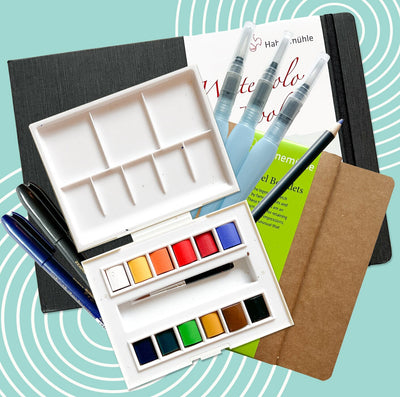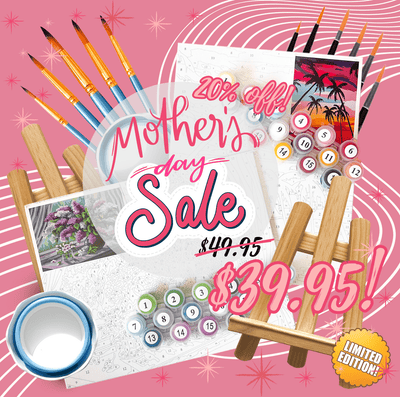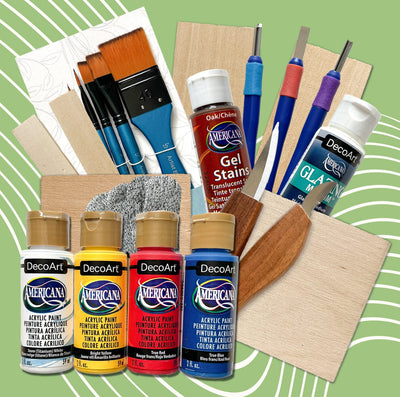Modern calligraphy is an artistic lettering medium open to versatility, experimentation, and the development of skills that lie outside of the traditional calligraphy toolbox.
Contemporary pointed-pen calligraphy often uses colorful watercolor, backgrounds, flourish designs, and painted flowers. You might see these modern techniques spilling their ink across mail art, wedding and event invitations, as well as other paper crafts. Nor are the uses of calligraphy limited to correspondence, as contemporary calligraphy styles make beautiful home decorations, such as wall calendars and framed quotations.
If you need some new ideas for exploring and experimenting with modern pointed-pen art, here are a few techniques to get your creative inks flowing:
1. Faux Calligraphy

One of the best ways to practice modern calligraphy is by trying out faux calligraphy. Faux calligraphy uses pointed pen styles without the pointed pen itself, and can be done with pencil, markers or even ball-point pens.
To do faux calligraphy, practice writing your lettering as uniformly as possible. Then draw in thicker lines where a letter has a downstroke. Some artists even add in letter shadows to make them appear 3-dimensional, as well as colorful pen and marker effects.
Faux calligraphy allows you to practice your letters using the pens that you’ll probably be more comfortable with. Faux calligraphy is also more travel-friendly than your typical dip pen practice, since it does not require ink bottles or a completely stable surface.
2. Alter Traditional Calligraphy to Create Modern Calligraphy Hands

When it comes to contemporary writing styles, it’s not totally necessary to learn new handwriting. You can develop modern styles from the pointed pen letters that you already know. Instead of starting from scratch to learn a new calligraphy hand, you can give your traditional one a few tweaks to create beautiful modern effects with a classic twist.
- Traditional handwriting-style calligraphy can take on a bold-elegance when you practice thickening your downstrokes. To avoid rail-roading or losing control in this style don’t attempt extra-thick downstrokes by flexing your nib too widely. Instead, practice leaving room to thicken the downstroke manually, so that you can add to it by drawing a second line, the same way you would when practicing faux calligraphy.
- Create a beautifully simplistic style with small lowercase letters and long connecting strokes. Long connecters add a sense of restful fluidity to your writing. You can emphasize this effect by writing letters that are even smaller than your normal calligraphic lower-case alphabet.
- Change the mood of your writing by adjusting the slant and angle of your letters. If you’ve practiced traditional pointed-pen calligraphy, then you know that keeping a strict angle to your writing is the key to nailing a traditional style. When you want to go a little more modern with your letters, you can manipulate this angle, by either making it more or less extreme. Experiment by drawing new guidelines to practice with and rotating your paper to allow for more freedom of movement.
- For a relaxed and playful style try modifying your pointed pen hand to have large loops and letter variation. This carefree style reminds its viewers that beauty can just as easily be found in free forms as in perfection. Don’t be afraid to create up-swinging line-connectors and letters that don’t perfectly line up.
- Try out a more cramped and straight style to illustrate those times when your words don’t feel like they’re flowing easily. You can practice using a straighter angle in while writing with your basic handwriting calligraphy. Then try to write with fewer loops, instead turning your loops into corners.
3. Play Around with Different Mediums and Inks

Contemporary calligraphy does not limit itself to traditional India ink and gouache. Instead, it expands the calligraphic style with experimentations in media, including dyes, and pigments.
- Writing with watercolor will allow you the freedom of writing in any color that you can conceivably mix. Watercolor gives you remarkable control over your writing, as you can pack it as dense with pigment, or alternatively, as translucent as you like. This is also a great way to experiment with ombre effects in your calligraphic compositions.
To write with watercolors, you will need watercolors, water for diluting and cleaning your brush and pen, and a brush. Use the water and brush to dilute the paint until it has the desirable consistency and translucency. Then, transfer the paint to the pen, using the brush directly on the pen nib.
Using watercolors with pointed pen also gives you the opportunity to create colorful and detailed sketches and brush flowers to illustrate your calligraphy.
- To make your words pop, try writing with white ink on colored paper. There are a few excellent opaque white inks on the market than can help add some elegance to a deep red envelope, the chalkboard effect to a black page, or a starry quotation to a watercolor-painted galaxy background.
- Metallic inks and metallic watercolors can help to gild your words without your having to splurge on gold leafing. Many metallic inks come as watercolors in a pan, making it easy for you to dilute them to the proper consistency. These inks make a beautiful and stately presence on paper, and they even look good as they are drying.
4. Attempt Modern Flourishes

Contemporary flourishing and be anywhere on the scale from minimal to abundant. Just as modern calligraphy can be as bare-bones or as curly as you want, your flourishes can be anything, from classic entwined ovals, to contour illustrations and designs.
Many contemporary calligraphers forego traditional pointed pen flourishes for watercolor art or pencil illustrations that accompany their words. However, a few take the elements of traditional pointed pen flourishing even further by drawing thematic animals, feather designs, and other line art.
Contemporary pointed pen calligraphy is all about customization. Once you find the style that you like to write in, develop it with a matching ink, watercolor or metallic medium, the ideal paper to suit it, and a few well-place flourishes that add a beautiful balance to your words.


